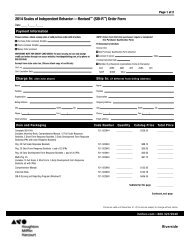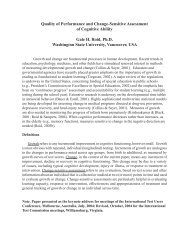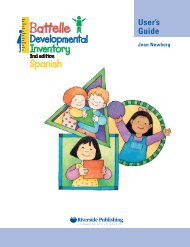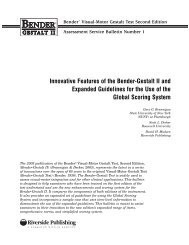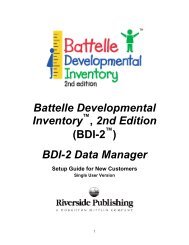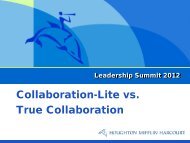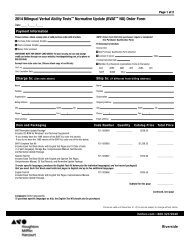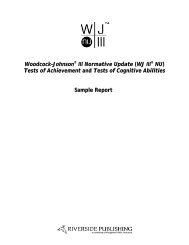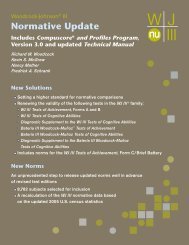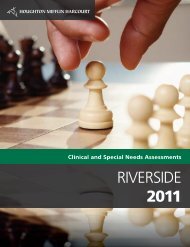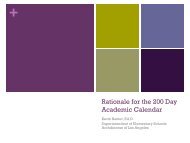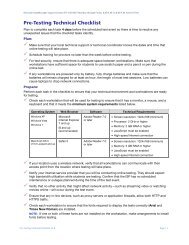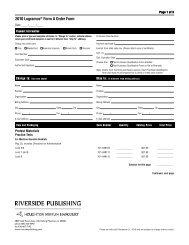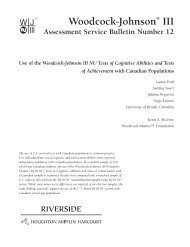Woodcock- Johnson III Tests of Cognitive Abilities - Riverside ...
Woodcock- Johnson III Tests of Cognitive Abilities - Riverside ...
Woodcock- Johnson III Tests of Cognitive Abilities - Riverside ...
Create successful ePaper yourself
Turn your PDF publications into a flip-book with our unique Google optimized e-Paper software.
<strong>Woodcock</strong>-<strong>Johnson</strong> ®<strong>III</strong>Assessment Service Bulletin Number 10Educational Interventions and Accommodations Related tothe <strong>Woodcock</strong>-<strong>Johnson</strong> <strong>III</strong> <strong>Tests</strong> <strong>of</strong> <strong>Cognitive</strong> <strong>Abilities</strong> and the<strong>Woodcock</strong>-<strong>Johnson</strong> <strong>III</strong> Diagnostic Supplement to the<strong>Tests</strong> <strong>of</strong> <strong>Cognitive</strong> <strong>Abilities</strong>Fredrick A. Schrank, PhDBarbara J. Wendling, MAThis bulletin relates the <strong>Woodcock</strong>-<strong>Johnson</strong> <strong>III</strong> <strong>Tests</strong> <strong>of</strong> <strong>Cognitive</strong> <strong>Abilities</strong>(WJ <strong>III</strong> ® COG) and the <strong>Woodcock</strong>-<strong>Johnson</strong> <strong>III</strong> Diagnostic Supplementto the <strong>Tests</strong> <strong>of</strong> <strong>Cognitive</strong> <strong>Abilities</strong> (DS) to educational interventions andaccommodations. The Cattell-Horn-Carroll (CHC) broad and narrow abilitiesand descriptions <strong>of</strong> the cognitive processes required for performance on each testprovide the theoretical and conceptual bases for suggested links between the WJ <strong>III</strong>COG and DS and a number <strong>of</strong> evidence-based instructional interventions. Researchdiscussed in this bulletin suggests that the CHC abilities (and, by inference,their constituent cognitive processes) are related to specific academic abilities.Consequently, educational interventions or accommodations that address relatedcognitive limitations may be foundational to improved performance in academicareas where learning difficulties are manifested.
Copyright © 2009 by The <strong>Riverside</strong> Publishing Company. All rights reserved. No part <strong>of</strong> this work may bereproduced or transmitted in any form or by any means, electronic or mechanical, including photocopyingand recording or by any information storage or retrieval system without the prior written permission <strong>of</strong>The <strong>Riverside</strong> Publishing Company unless such copying is expressly permitted by federal copyright law.Address inquiries to Permissions, The <strong>Riverside</strong> Publishing Company, 3800 Golf Road, Suite 100, RollingMeadows, IL 60008-4015.Printed in the United States <strong>of</strong> America.<strong>Woodcock</strong>-<strong>Johnson</strong>, WJ <strong>III</strong>, and the WJ <strong>III</strong> logo are registered trademarks <strong>of</strong> Houghton Mifflin HarcourtCompany, and the WJ <strong>III</strong> NU logo is a trademark <strong>of</strong> Houghton Mifflin Harcourt Company.Reference Citation■ To cite this document, use:Schrank, F. A., & Wendling, B. J. (2009). Educational interventions and accommodations related tothe <strong>Woodcock</strong>-<strong>Johnson</strong> ® <strong>III</strong> <strong>Tests</strong> <strong>of</strong> <strong>Cognitive</strong> <strong>Abilities</strong> and the <strong>Woodcock</strong>-<strong>Johnson</strong> <strong>III</strong> DiagnosticSupplement to the <strong>Tests</strong> <strong>of</strong> <strong>Cognitive</strong> <strong>Abilities</strong> (<strong>Woodcock</strong>-<strong>Johnson</strong> <strong>III</strong> Assessment Service BulletinNo. 10). Rolling Meadows, IL: <strong>Riverside</strong> Publishing.For technical information, please call 800.323.9540 or visit our website at www.woodcock-johnson.com.1 2 3 4 5 6 7 8 9 10-XBS-12 11 10 09
Educational Interventions andAccommodations Related to the <strong>Woodcock</strong>-<strong>Johnson</strong> <strong>III</strong> <strong>Tests</strong> <strong>of</strong> <strong>Cognitive</strong> <strong>Abilities</strong> and the<strong>Woodcock</strong>-<strong>Johnson</strong> <strong>III</strong> Diagnostic Supplement tothe <strong>Tests</strong> <strong>of</strong> <strong>Cognitive</strong> <strong>Abilities</strong>The <strong>Woodcock</strong>-<strong>Johnson</strong> <strong>III</strong> <strong>Tests</strong> <strong>of</strong> <strong>Cognitive</strong> <strong>Abilities</strong> (WJ <strong>III</strong> COG) (<strong>Woodcock</strong>, McGrew,& Mather, 2001, 2007) and the <strong>Woodcock</strong>-<strong>Johnson</strong> <strong>III</strong> Diagnostic Supplement to the <strong>Tests</strong> <strong>of</strong><strong>Cognitive</strong> <strong>Abilities</strong> (DS) (<strong>Woodcock</strong>, McGrew, Mather, & Schrank, 2003, 2007) include 31tests for measuring general intellectual ability, broad and narrow cognitive abilities, andaspects <strong>of</strong> executive functioning. The WJ <strong>III</strong> COG includes 20 tests. The DS provides 11additional tests.Each <strong>of</strong> the WJ <strong>III</strong> COG and DS tests provide norm-referenced measures <strong>of</strong> one ormore narrow, or specific, psychometrically defined cognitive abilities as informed by theindependent research efforts <strong>of</strong> Horn (1965, 1988, 1989, 1991), Horn and Stankov (1982),Cattell (1941, 1943, 1950), Carroll (1987, 1990, 1993, 2003), and <strong>Woodcock</strong> (1998). Thisbody <strong>of</strong> research has been interpreted conjointly as CHC theory (McGrew, 2005).The WJ <strong>III</strong> COG and DS measure seven broad CHC abilities: Comprehension-Knowledge (Gc), Long-Term Retrieval (Glr), Visual-Spatial Thinking (Gv), AuditoryProcessing (Ga), Fluid Reasoning (Gf ), Processing Speed (Gs), and Short-Term Memory(Gsm). These seven broad abilities are differentially related to reading, math, and writingachievement (Evans, Floyd, McGrew, & Leforgee, 2002; Floyd, Evans, & McGrew, 2003;Floyd, McGrew, & Evans, 2008).Each <strong>of</strong> the WJ <strong>III</strong> COG and DS tests can also be interpreted as measuring one ormore cognitive processes (McGrew, Schrank, & <strong>Woodcock</strong>, 2007; Schrank, 2006).The cognitive processes required for performance on each <strong>of</strong> the tests can providecues to interventions that may enhance performance on similar educational tasks. “Animplication, borne out in research, is that student performance should improve whenteachers structure instruction and academic work to cue effective processing” (Wong,Harris, Graham, & Butler, 2003, p. 392).CHC <strong>Abilities</strong>, Constituent <strong>Cognitive</strong> Processes, and RelatedEducational Interventions and AccommodationsAlthough it is generally accepted that an identified weakness in a particular cognitiveability is useful for describing why a student is struggling in one academic areabut not another, the relationship between the identified weakness, the cognitive
processes required for academic performance in the affected domain, and instructionalinterventions is not as widely understood. As the focus <strong>of</strong> pr<strong>of</strong>essional practice shiftsfrom determining service eligibility to assessing basic psychological processes that informappropriate instruction, a need exists for providing a link between cognitive assessmentand evidence-based educational interventions. Research has shown that the CHC broadand narrow abilities differentially predict performance on academic tasks (Evans, et al.,2002; Floyd, et al., 2003; Floyd, et al., 2008). This bulletin describes some differentialimplications for planning appropriate interventions and/or selection <strong>of</strong> accommodationsbased on an assessment <strong>of</strong> the CHC broad and narrow abilities as identified by the WJ <strong>III</strong>COG and DS.The purpose <strong>of</strong> this bulletin is to describe how information gleaned from performanceon the WJ <strong>III</strong> COG and DS can be useful for developing instructional interventions oraccommodations, particularly when limited pr<strong>of</strong>iciency is identified in a broad or narrowability and/or associated with a specific cognitive process. To provide an organizationalschema that relates WJ <strong>III</strong> COG and DS test performance to evidence-based interventions,this bulletin outlines the broad factors and narrow abilities defined by CHC theory andprovides brief descriptions <strong>of</strong> the cognitive processes required for performance in each<strong>of</strong> the tests. Suggested interventions or accommodations that are conceptually relatedto the narrow abilities and cognitive processes are included (see Table 1). As examples,some interventions are described in this bulletin. References to research evidence for eachsuggested intervention are provided for further information.Table 1.Organizational Schema Relating WJ <strong>III</strong> COG and Diagnostic Supplement <strong>Tests</strong>,CHC Broad Factors and Narrow <strong>Abilities</strong>, <strong>Cognitive</strong> Processes, andRelated Educational InterventionsTestTest 1: Verbal Comprehension Comprehension-Knowledge (Gc )Lexical knowledgeLanguage developmentTest 2: Visual-AuditoryLearningPrimary Broad CHC FactorsNarrow CHC <strong>Abilities</strong> <strong>Cognitive</strong> Process(es) Related Educational InterventionsLong-Term Retrieval (Glr )Associative memoryTest 3: Spatial Relations Visual-Spatial Thinking (Gv )VisualizationSpatial relationsTest 4: Sound Blending Auditory Processing (Ga )Phonetic codingObject recognition andreidentification; semanticactivation, access, andmatching; verbal analogicalreasoningPaired-associative encodingvia directed spotlightattention; storage andretrievalVisual feature detection;manipulation <strong>of</strong> visualimages in space; matchingSynthesis <strong>of</strong> acoustic,phonological elementsin immediate awareness;matching the sequence <strong>of</strong>elements to stored lexicalentries; lexical activation andaccessCreating a vocabulary-rich learningenvironment, particularly reading aloud toa young child and discussing new words;text talks; directed vocabulary thinkingactivities; explicit teaching <strong>of</strong> specific words;semantic feature analysis; semantic maps;use <strong>of</strong> computer technology to develop wordknowledge; association <strong>of</strong> key words to priorknowledge; reading for a variety <strong>of</strong> purposes;independent word-learning strategiesActive, successful learning experiences;rehearsal; overlearning; organizationalstrategies; mnemonics; illustrate or visualizecontentMultisensory teaching techniques; privatespeechEarly exposure to language sounds; promotingphonological awareness; direct instruction insound blending; practice blending sounds intowords
Table 1, continuedOrganizational Schema Relating WJ <strong>III</strong> COG and Diagnostic Supplement <strong>Tests</strong>,CHC Broad Factors and Narrow <strong>Abilities</strong>, <strong>Cognitive</strong> Processes, andRelated Educational InterventionsTest 5: Concept Formation Fluid Reasoning (Gf )InductionTest 6: Visual Matching Processing Speed (Gs )Perceptual speedTest 7: Numbers Reversed Short-Term Memory (Gsm )Working memoryTest 8: Incomplete Words Auditory Processing (Ga )Phonetic codingTest 9: Auditory WorkingMemoryTest 10: Visual-AuditoryLearning–DelayedShort-Term Memory (Gsm )Working memoryLong-Term Retrieval (Glr )Associative memoryTest 11: General Information Comprehension-Knowledge (Gc )General (verbal) informationTest 12: Retrieval Fluency Long-Term Retrieval (Glr )Ideational fluencyNaming facilityTest 13: Picture Recognition Visual-Spatial Thinking (Gv )Visual memoryTest 14: Auditory Attention Auditory Processing (Ga )Speech-sound discriminationResistance to auditory-stimulusdistortionTest 15: Analysis-Synthesis Fluid Reasoning (Gf )General sequential reasoningQuantitative reasoningTest 16: Decision Speed Processing Speed (Gs )Semantic processing speedTest 17: Memory for Words Short-Term Memory (Gsm )Auditory memory spanTest 18: Rapid Picture Naming Processing Speed (Gs )Naming facilityRule-based categorization;rule switching; induction/inferenceSpeeded visual perceptionand matchingSpan <strong>of</strong> apprehension andrecoding in working memoryAnalysis <strong>of</strong> a sequence<strong>of</strong> acoustic, phonologicalelements in immediateawareness; activation <strong>of</strong> astored representation <strong>of</strong> theword from an incomplete set<strong>of</strong> phonological featuresRecoding <strong>of</strong> acoustic,verbalizable stimuli held inimmediate awarenessRetrieval and reidentification;associative encoding (forrelearning)Semantic activation andaccess to declarative genericknowledgeRecognition, fluent retrieval,and oral production <strong>of</strong>examples <strong>of</strong> a semanticcategoryFormation <strong>of</strong> iconicmemories and matching<strong>of</strong> visual stimuli to storedrepresentationsSelective auditory attentionAlgorithmic reasoning;deductionObject recognition andspeeded symbolic/semanticcomparisonsFormation <strong>of</strong> echoicmemories and verbalizablespan <strong>of</strong> echoic storeSpeed/fluency <strong>of</strong> retrievaland oral production <strong>of</strong>recognized objectsCategorize using real objects; develop skills indrawing conclusions; hands-on problem-solvingtasks; make meaningful associations; concreteexamples <strong>of</strong> grouping objectsEmphasize speediness; build cognitive speed viarepetition, speed drills; use <strong>of</strong> technologyChunking strategies; rehearsal; mnemonicsPromote phonological awareness; read aloud;games that focus on sounds and wordsRehearsal; mnemonics; active learningActive, successful learning experiences;rehearsal; overlearning; organizationalstrategies; mnemonics; illustrate or visualizecontentText talks; semantic mapsOral elaborationActivities designed to discriminate/match visualfeatures and recall visual informationReduce distracting noise; modifications tolistening environmentDeductive reasoning using concrete objects;hands-on problem solving tasks; metacognitivestrategiesEmphasize speediness; build cognitive speed viarepetitionMnemonics; rehearsal; provide visual cuesIncrease fluency through self-competition
Table 1, continuedOrganizational Schema Relating WJ <strong>III</strong> COG and Diagnostic Supplement <strong>Tests</strong>,CHC Broad Factors and Narrow <strong>Abilities</strong>, <strong>Cognitive</strong> Processes, andRelated Educational InterventionsTest 19: PlanningVisual-Spatial Thinking (Gv ) andFluid Reasoning (Gf )Spatial scanningGeneral sequential reasoningTest 20: Pair Cancellation Processing Speed (Gs )Attention and concentrationTest 21: Memory for Names Long-Term Retrieval (Glr )Associative memoryTest 22: Visual Closure Visual-Spatial Thinking (Gv )Closure speedTest 23: Sound Patterns–Voice Auditory Processing (Ga )Sound discriminationTest 24: Number Series Fluid Reasoning (Gf )Mathematics knowledgeQuantitative reasoningTest 25: Number Matrices Fluid Reasoning (Gf )Quantitative reasoningTest 26: Cross Out Processing Speed (Gs )Perceptual speedTest 27: Memory for Sentences Short-Term Memory (Gsm )Auditory memory spanListening abilityTest 28: Block Rotation Visual-Spatial Thinking (Gv )VisualizationSpatial relationsTest 29: Sound Patterns–Music Auditory Processing (Ga )Sound discriminationMusical discrimination andjudgmentTest 30: Memory forNames–DelayedTest 31: Bilingual VerbalComprehension–English/SpanishLong-Term Retrieval (Glr )Associative memoryComprehension-Knowledge (Gc )Lexical knowledgeLanguage developmentMeans-end analysisControlled, focal attention;vigilanceAssociative encoding viadirected spotlight attention,storage, and retrievalObject identification froma limited set <strong>of</strong> componentgeonsPrelexical, perceptual analysis<strong>of</strong> auditory waveform patternsRepresentation andmanipulation <strong>of</strong> points on amental number line; identifyingand applying an underlyingrule/principle to complete anumerical sequenceAccess to verbal-visualnumeric codes; transcodingverbal and/or visualrepresentations <strong>of</strong> numericinformation into analogicalrepresentations; determiningthe relationship between/among numbers on the firstpart <strong>of</strong> the structure andmapping (projecting) thestructure to complete theanalogySpeeded visual matchingFormation <strong>of</strong> echoic memoriesaided by a semantic, meaningbasedcodeVisual matching using visualspatialmanipulationPrelexical, perceptual analysis<strong>of</strong> auditory waveform patternsReidentificationObject reidentification;semantic activation, access,and matching; verbalanalogical reasoningUse <strong>of</strong> puzzles, pegboards, dot-to-dot drawings;multisensory teaching techniques; privatespeechSpeed drills; repetitionActive, successful learning experiences;rehearsal; overlearning; organizational strategies;mnemonics; illustrate or visualize contentAccommodations to enhance visual stimuli (e.g.,enlarge, use color overlays)Auditory training; enhancements/modificationsto listening environmentDevelop number sense; count by increments;manipulativesSeriation; patterns; explicit instruction innumber reasoning skillsEmphasize speediness; build cognitive speed viarepetitionAssociate new information with prior knowledge;rehearsalUse <strong>of</strong> puzzles, pegboards, dot-to-dot drawings;multisensory teaching techniques; privatespeechAuditory training; enhancements/modificationsto listening environmentInterventions/accommodations to help recallpreviously learned informationSee Test 1: Verbal Comprehension
Comprehension-Knowledge (Gc )The CHC broad ability, Comprehension-Knowledge (Gc), is sometimes referred to asacculturation knowledge, crystallized intelligence, or verbal abilities. It is typically viewedas a store <strong>of</strong> acquired knowledge that includes both declarative and procedural knowledge.For children and adolescents, Comprehension-Knowledge (Gc) is moderately to stronglyrelated to reading (Evans, et al., 2002), mathematics (Floyd, et al., 2003), and writing(Floyd, et al., 2008) achievement. Oral language ability, an aspect <strong>of</strong> Gc, serves as thefoundation for, and is positively related to, subsequent success in reading and writing(Glazer, 1989; Stanovich, 1986; Strickland & Feeley, 1991; Wiig & Semel, 1984). Researchindicates significant relationships among level <strong>of</strong> oral vocabulary (Baumann & Kame’enui,1991), background knowledge (Anderson & Pearson, 1984), and reading ability.Two <strong>of</strong> the tests that compose the Gc cluster are Verbal Comprehension and GeneralInformation. The Verbal Comprehension test comprises four subtests: Picture Vocabulary,Synonyms, Antonyms, and Verbal Analogies. They measure the CHC narrow abilities <strong>of</strong>lexical knowledge (i.e., vocabulary knowledge) and language development (i.e., generaldevelopment <strong>of</strong> spoken language skills that do not require reading ability). In contrast,the General Information test measures the CHC narrow ability <strong>of</strong> general (verbal)information.The cognitive processing involved in lexical knowledge may be illustrated best inthe Synonyms and Antonyms tasks, wherein an auditory form <strong>of</strong> a stimulus word isconnected to a concept via semantic access. The Synonyms and Antonyms subtests areprimarily language development tasks because the stimulus material involves no printedwords (lexical retrieval cannot be accessed via reading). Both narrow abilities (lexicalknowledge and language development) are measured in the Picture Vocabulary subtest.The Verbal Analogies subtest comprises cognitively complex tasks that require induction<strong>of</strong> the structure for the first part <strong>of</strong> each analogy and then mapping (or projecting) thatstructure onto the second part.For young children, suggested interventions that encourage the development <strong>of</strong>knowledge and language abilities include creating a language- and experience-richenvironment (Gunn, Simmons, Kame’enui, 1995; Hart & Risley, 2003), frequent exposureand practice with words (Gunn, et al., 1995; Hart & Risley, 2003), reading aloud to thechild (Adams, 1990), and text talks (Beck & McKeown, 2001).For example, when creating a language- and experience-rich environment, the childshould be provided with early exposure to language and word knowledge. Opportunitiesfor role playing; sharing time; and hands-on activities with new, interesting vocabularyhelp young children acquire new vocabulary and incorporate it into their daily language.Frequent exposure and practice are essential for children to learn new words well enoughto recall them, to know their meaning, and to use them. At home, parents should engagethe child in talk about what is happening during the day. They might describe and labelthings, as well as name objects and actions, as they interact each day with their child.Parents should ask lots <strong>of</strong> questions; answer the child’s “why” questions; and take trips tothe library, museum, zoo, and/or provide other opportunities for exposure to knowledge.Text talks are teacher-led discussions that engage the child in a dialog about a storythat was read and the vocabulary that was used. The teacher makes connections betweennew words and words and experiences already in the child’s repertoire. The teachermodels new words by paraphrasing using known words.
For older children and adolescents, interventions include increased time spent reading(Cunningham & Stanovich, 1991; Herman, Anderson, Pearson, & Nagy, 1987), readingfor different purposes (Anderson, 1996; National Reading Panel, 2000; Stahl, 1999),intentional, explicit word instruction (Beck, McKeown, & Kucan, 2002; Graves, Juel, &Graves, 2004; National Reading Panel, 2000), direct instruction in morphology (Anglin,1993; Baumann, Edwards, Boland, Olejnik, & Kame’enui, 2003; Baumann, Kame’enui, &Ash, 2003; Blachowicz & Fisher, 2000; Carlisle, 2004; Graves, 2000; National ReadingPanel, 2000), development <strong>of</strong> word consciousness (Anderson & Nagy, 1992; Graves& Watts-Taffe, 2002; Nagy & Scott, 2000), and use <strong>of</strong> related computer programs(Davidson, Elcock, & Noyes, 1996).Vocabulary-building interventions for older children and adults include semanticfeature analysis (Anders & Bos, 1986; Pittelman, Heimlich, Berglund, & French, 1991)and semantic maps (<strong>Johnson</strong> & Pearson, 1984; Sinatra, Berg, & Dunn, 1985). Bothmethods provide a visual representation <strong>of</strong> the information to be studied. Semantic maps,for example, involve brainstorming words and phrases that are associated with a majorconcept being studied. Then the individual identifies which words/phrases go together insome way. These groups <strong>of</strong> related words/phrases are then labeled and form supportingdetails for the major concept.Long-Term Retrieval (Glr )The CHC broad ability Long-Term Retrieval (Glr) involves the cognitive processes <strong>of</strong>acquiring, storing, and retrieving information. Glr reflects the efficiency with whichinformation is initially stored and later retrieved. Long-Term Retrieval (Glr) is relatedto reading achievement during the elementary school years (Evans, et al., 2002), tomathematics achievement during the same period (Floyd, et al., 2003), and to writingachievement in the early elementary school years (Floyd, et al., 2008). Naming facility,<strong>of</strong>ten referred to as rapid automatic naming (RAN), is a narrow ability subsumed by Glr.RAN has been found to predict reading achievement (Scarborough, 1998).Two tests that compose the Glr cluster are Visual-Auditory Learning and RetrievalFluency. Visual-Auditory Learning measures associative memory or paired-associatelearning, and Retrieval Fluency measures ideational fluency and naming facility. InVisual-Auditory Learning, the initial task requires associating the visual rebus symbolwith a verbal label. The controlled-learning format <strong>of</strong> this test uses directed spotlightattention (Gazzaniga, Ivry, & Mangun, 1998)—the mental, attention-focusing processthat prepares the examinee to encode the stimulus. The retrieval phase requires theexaminee to match a rebus presentation with its stored representation; this process iscalled identification. The directed-spotlight attention mechanism provides a cue to theintervention known as active learning (Marzano, Pickering, & Pollock, 2001). Activelearning is required for the creation <strong>of</strong> meaning-based codes that are subsequently usedto relate new information or task requirements to previously acquired knowledge.The Retrieval Fluency test requires fluent retrieval and oral production <strong>of</strong> examples <strong>of</strong>a semantic category. This task does not include the encoding and storage processes butrather measures the rate or automaticity <strong>of</strong> retrieval. Oral elaboration (Wolf, Bowers, &Biddle, 2000; Wolfe, 2001) may be an effective intervention for limited performance ornonautomatic oral production <strong>of</strong> names in a semantic category.Additional Glr tests are included in Table 1. For example, Memory for Names alsomeasures associative memory. The educational interventions for limited pr<strong>of</strong>iciency onMemory for Names are similar to those for Visual-Auditory Learning.
Interventions for limitations in encoding, storing, and retrieving information includeactive learning (Marzano, et al., 2001), rehearsal, overlearning, elaboration (Squire &Schacter, 2003), mnemonics (Wolfe, 2001), visual representation (Greenleaf & Wells-Papanek, 2005), and organizational strategies. Varying the learning tasks, incorporatingemotions and novelty, and fostering creativity are ways to promote active learning.Rehearsal is a critical factor in learning. Memories consolidate across time, so someindividuals may benefit from shorter sessions at repeated intervals rather than one longsession. For students with limitations, dividing learning into three, 50-minute sessionswith 10-minute breaks in between sessions may be preferable to a single, three-hourstudy period. Recitation is one method <strong>of</strong> rehearsal. The individual reviews his or hernotes on the information, covers the notes, and then recites aloud the material to belearned. This oral recitation technique incorporates more senses than just thinking aboutthe notes and leads to better recall. Overlearning improves storage and recall. It occurswhen the individual continues to review and rehearse information he or she alreadyknows. Even one additional review can significantly increase recall.Visual-Spatial Thinking (Gv )Visual-spatial thinking (Gv) involves visual perception (the process <strong>of</strong> extracting featuresfrom visual stimuli) and includes the processes involved in generating, storing, retrieving,and transforming visual images. While the ability to make sense <strong>of</strong> visual informationis important to school success, the research has not shown a meaningful connectionbetween achievement and the visual processing tasks found on most intelligence tests(Evans, et al., 2002; Floyd, et al., 2003; Floyd, et al., 2008). In clarifying the relationshipbetween visual processing and reading, Berninger (1990) points out that these visualperceptual abilities should not be confused with the orthographic code-processingabilities important during reading. In addition, a few research studies have indicateda relationship between visual processing and higher-level math achievement, such asgeometry or calculus (Hegarty & Kozhevnikov, 1999).Spatial Relations and Picture Recognition are two <strong>of</strong> the tests that create the Gvcluster. Spatial Relations measures the ability to use visualization (the skill to apprehendspatial forms or shapes, <strong>of</strong>ten by rotating or manipulating them in the imagination <strong>of</strong> the“mind’s eye”). Picture Recognition is a visual memory task.Individuals with limited performance in one or more <strong>of</strong> the visual-spatial thinkingabilities may benefit from interventions designed to develop skills in discriminatingvisual features, mentally manipulating visual images, matching, and recalling visualinformation (Greenleaf & Wells-Papanek, 2005). Students may benefit from multisensoryteaching techniques that make use <strong>of</strong> multiple sensory pathways to introduce andpractice the information to be learned (Williams, Richman, & Yarbrough, 1992). Forexample, tactile/kinesthetic activities may enhance learning by incorporating multiplesenses into the instructional process. For students in grades 3 and above, cognitivebehavioralinterventions (such as using private speech to initiate, direct, or maintain abehavior) (Meichenbaum, 1977) may be applied to visual-spatial tasks.In certain instances, accommodations that compensate for limitations in visualprocessing may be necessary. Some example accommodations include enlarging printmaterials, reducing the amount <strong>of</strong> visual information the student sees at one time,providing tools to support visual tracking, reading directions aloud, making use <strong>of</strong>color coding, using a tape recorder or a note buddy to reduce the need to take notes,providing extended time or shortening assignments, and using colored lenses or overlays
to enhance visual perception. It may be helpful to provide repeated exposures to printedvisuals, isolate visual information that is presented (e.g., exposing only certain visualinformation on a page), or use auditory modalities to compensate for limitations invisual memory.Table 1 identifies and outlines the cognitive processing requirements and relatededucational interventions for the other WJ <strong>III</strong> COG and DS Gv tests—Planning, VisualClosure, and Block Rotation.Auditory Processing (Ga )Auditory Processing (Ga) is a broad CHC ability that involves auditory perception (theprocess <strong>of</strong> extracting features from auditory stimuli) and includes a wide range <strong>of</strong> abilitiesthat are needed to discriminate, analyze, synthesize, comprehend, and manipulatesounds. Auditory Processing is related to reading achievement in the elementary schoolyears (Evans, et al., 2002). In particular, phonological awareness, an aspect <strong>of</strong> auditoryprocessing, is an important prerequisite to reading competence (Adams, 1990).Two <strong>of</strong> the tests that compose the Ga cluster are Sound Blending and AuditoryAttention. Sound Blending is a measure <strong>of</strong> phonetic coding, and Auditory Attentionmeasures speech-sound discrimination and resistance to auditory-stimulus distortion.For young children, possible interventions include early exposure to sounds, music,rhythms, and language (Glazer, 1989; Strickland, 1991), reading aloud to the child(Adams, 1990; Anderson, Hiebert, Scott, & Wilkinson, 1985), providing opportunitiesthat encourage exploration and manipulation <strong>of</strong> sounds, words, and language (Adams,1990), and daily practice with language (Bridge, Winograd, & Haley, 1983).For example, a young child can be taken on a “sound walk” around the house orclassroom. Introduce Tommy Clock, who says, /t/-/t/-/t/; listen to the clock as it ticks.Find Furry Kitty who bites her lip and says, /f/-/f/-/f/ or Sammy Snake who says,/s/-/s/-/s/. Playing with sounds in this way will lay a foundation and get the child readyfor phonics. Focus the child’s attention on the sounds that occur in the environment. Theinstructional objective is to get the child to imitate the sounds after they are modeled bythe adult.For school-aged children and some adolescents with limited phonemic awareness,interventions include explicit, systematic instruction in phonics (National Reading Panel,2000), use <strong>of</strong> decodable texts for daily practice (Meyer & Felton, 1999), and books ontape to increase exposure to the sounds <strong>of</strong> language (Carbo, 1989). For example, bookson tape provide opportunities to hear correct word pronunciation and prosody. Thisexposure will help the student develop phonological awareness as well as make theconnection between sounds and printed words.In addition, it may be beneficial to structure the student’s learning environment toreduce distracting noise and increase his or her ability to selectively attend to relevantauditory stimuli (Bellis, 2003). Accommodations could include maintaining a low noiselevel in the classroom or seating the student close to the primary channels <strong>of</strong> auditoryinformation (Zentall, 1983).Table 1 identifies and outlines the cognitive processing requirements and relatededucational interventions/accommodations for the other WJ <strong>III</strong> COG and DS Ga tests—Incomplete Words, Sound Patterns–Voice, and Sound Patterns–Music.
Fluid Reasoning (Gf )Reasoning is a complex, hierarchical cognitive function that can rely on many othercognitive processes, depending on the nature and requirements <strong>of</strong> the task. Inductive anddeductive reasoning are the hallmarks <strong>of</strong> this broad CHC ability. Reasoning also <strong>of</strong>tenrelies on emergent properties; that is, those functions that cannot be predicted based onsimple interactions between other functions. Nevertheless, certain narrow abilities havebeen identified by CHC theory based on different types <strong>of</strong> reasoning processes. FluidReasoning (Gf ) is related to mathematics achievement (Floyd, et al., 2003), readingcomprehension (Evans, et al., 2002), and writing ability (Floyd, et al., 2008; McGrew &Knopik, 1993).Concept Formation (a measure <strong>of</strong> induction or inference) and Analysis-Synthesis(a measure <strong>of</strong> general sequential reasoning or deductive reasoning) are two tests thatcompose the Gf cluster. The Concept Formation task requires rule application andfrequent switching from one rule to another. Analysis-Synthesis requires drawing correctconclusions from stated conditions or premises, <strong>of</strong>ten from a series <strong>of</strong> sequential steps.Because <strong>of</strong> its use <strong>of</strong> specific solution keys that, if followed correctly, furnish the correctanswer to each test item, Analysis-Synthesis can also be described as a measure <strong>of</strong>algorithmic reasoning. In CHC theory, algorithmic reasoning is an aspect <strong>of</strong> quantitativereasoning.Interventions that are designed to develop skills in categorization and drawingconclusions, that involve connecting new concepts to prior knowledge, that useteacher demonstrations and guided practice, and provide feedback on performance maypositively influence the development <strong>of</strong> reasoning abilities (Klauer, Willmes, & Phye,2002). Repeated opportunities to sort and classify objects are important in developingreasoning skills (Quinn, 2004). Hands-on problem-solving tasks provide opportunities tobe actively engaged in learning. These tasks need to be demonstrated by a teacher using athink-aloud procedure to model the steps involved in solving the problem.For young children, there are a variety <strong>of</strong> games designed to help develop earlyreasoningskills such as matching, finding similarities and differences, and categorizing.Use <strong>of</strong> games is a fun way to actively engage a child in learning these important skills.For example, play, “I’m thinking <strong>of</strong> something _______,” wherein an object is describedin terms <strong>of</strong> some concept or attribute, and the child must identify the object based onquestions he or she asks. Introduce the child to deductive reasoning using concreteobjects, and engage him or her in the learning process. Provide repetition and review. Askthe child to verbalize what he or she has learned.For older children and adults, interventions include cooperative learning groupsand reciprocal teaching (Palincsar & Brown, 1984), graphic organizers (Marzano, etal., 2001), and metacognitive strategies (Manning & Payne, 1996; Pressley, 1990).Cooperative learning groups and reciprocal teaching are effective ways to actively engagean individual in learning and to develop reasoning skills. Use <strong>of</strong> graphic organizers,such as Venn diagrams or concept maps, can help organize the information conceptually,linking new information to known information. Teaching metacognitive strategies andthen providing opportunities to practice the strategies is important in developing higherlevelreasoning skills. The individual is taught to think about the task, set goals, use selftalk,monitor progress, and then reward him- or herself when the task is accomplished.These metacognitive strategies help the individual to be aware <strong>of</strong>, monitor, and controlhis or her learning. Some specific strategies that might be incorporated include teaching9
the individual to compare new concepts to previously learned concepts or to useanalogies, metaphors, or similes when approaching a task (Greenleaf, 2005).Two additional Gf tests are included in the WJ <strong>III</strong> COG and DS. The NumberSeries test measures the ability to identify and apply an analog or rule to complete anumerical sequence. The mental representations (or “number sense”) that constitutethis ability form the basis for the ability to learn symbols for numbers and performsimple calculations (Dehaene, 1997, 2000). Number Matrices requires a foundation inmathematics knowledge (i.e., access to the category-specific verbal and visual codes,such as knowledge <strong>of</strong> the number line). However, in Number Matrices, the verbal and/orvisual codes are transcoded into analogical representations between sets <strong>of</strong> numbers.The solution to each item is obtained by mapping the relationship implied from the firstpart <strong>of</strong> the item onto the latter part <strong>of</strong> the item, thereby completing the analogy. Relatedinterventions involve explicit instruction in seriation and number reasoning skills (High/Scope Educational Research Foundation, 2003; Kroesbergen & Van Luit, 2003).Processing Speed (Gs )Efficiency <strong>of</strong> cognitive processing is based partly on the speed <strong>of</strong> mental activity. Formany years, cognitive speediness, or mental quickness, has been considered an importantaspect <strong>of</strong> intelligence (Nettelbeck, 1994; Vernon, 1983). “In the face <strong>of</strong> limited processingresources, the speed <strong>of</strong> processing is critical because it determines in part how rapidlylimited resources can be reallocated to other cognitive tasks” (Kail, 1991, p. 152).Processing Speed (Gs) is related to reading (Evans, et al., 2002), mathematics (Floyd, etal., 2003), and writing achievement (Floyd, et al., 2008; McGrew & Knopik, 1993).Two <strong>of</strong> the tests that compose the Gs cluster are Visual Matching and Decision Speed.Visual Matching is a perceptual speed measure, and Decision Speed measures speed<strong>of</strong> semantic processing (i.e., the speed <strong>of</strong> mental manipulation <strong>of</strong> stimulus content).Perceptual speed involves making comparisons based on rapid visual searches. Decisionspeed <strong>of</strong> semantic processing (i.e., the speed <strong>of</strong> mental manipulation <strong>of</strong> stimulus content)requires making symbolic comparisons <strong>of</strong> concepts. In contrast to decision making basedon physical comparisons, the semantic or acquired knowledge (rather than perceptualinformation) needed for the Decision Speed test influences the decision-making process.(Rapid Picture Naming and Pair Cancellation are also measures <strong>of</strong> processing speed.)There is some evidence that perceptual speed, as measured in Visual Matching orCross Out (another Gs test), is related to the orthographic processing required forreading. The rapid processing <strong>of</strong> visual symbols resembles the perceptual demands<strong>of</strong> reading. Research has confirmed the link between perceptual speed and reading(McGrew, 1993; McGrew, Flanagan, Keith, & Vanderwood, 1997).<strong>Cognitive</strong> speediness can sometimes be positively influenced by repetitive practice,speed drills, and use <strong>of</strong> computer games that require an individual to quickly makedecisions (Mahncke, Bronstone, & Merzenich, 2006; Tallal, et al., 1996). For example,repetition is an important factor in building speed. Repeated and extensive practicemay enable a student to perform the same tasks in a more automatic fashion to increasespeeded performance. Speed drills focus performance on quickly completing a task.When a student’s performance on familiar tasks is timed and progress monitored, speedmay increase. For example, the student might be asked to count aloud, or say the letters<strong>of</strong> the alphabet, as quickly as he or she can for 10 seconds. The number <strong>of</strong> numerals orletters named is recorded. The speed drill is repeated at regular intervals, recording thenumber <strong>of</strong> items named each time.10
Processing speed (Gs) is a well-researched cognitive process that has implicationsfor the provision <strong>of</strong> educational accommodations (Geary & Brown, 1990; Hayes, Hynd,& Wisenbaker, 1986; Kail, 1990, 1991, 2003; Kail, Hall, & Caskey, 1999; Ofiesh,2000; Shaywitz, 2003; Wolff, Michel, Ovrut, & Drake, 1990). Accommodations thatcompensate for limitations in processing or perceptual speed include providing extendedtime, reducing the quantity <strong>of</strong> work required (breaking large assignments into two ormore component assignments), eliminating or limiting copying activities, and increasingwait times both after questions are asked and after responses are given.Short-Term Memory (Gsm)Short-Term Memory (Gsm) is the ability to apprehend and maintain awareness <strong>of</strong>elements <strong>of</strong> information in the immediate situation (the last minute or so). It is a limitedcapacitysystem that includes the narrow abilities <strong>of</strong> memory span and working memory.Short-Term Memory is related to reading (Evans, et al., 2002), mathematics (Floyd, et al.,2003), and writing achievement (Floyd, et al., 2008).Numbers Reversed, a measure <strong>of</strong> working memory, and Memory for Words, ameasure <strong>of</strong> memory span, are two tests in the Gsm cluster. Numbers Reversed requiresthe ability to temporarily store and orally recode presented information (a subprocess<strong>of</strong> working memory). In this test, the individual is required to repeat a series <strong>of</strong> digitsbackward. Memory for Words measures the span <strong>of</strong> verbal (auditory) store by requiringthe individual to repeat a series <strong>of</strong> unrelated words. Memory for Sentences (anotherGsm test) also measures the span <strong>of</strong> verbal memory, but in this test, memory is aided bycontext (i.e., semantic, meaning-based code).Interventions for limitations in short-term memory include making meaningfulconnections between prior knowledge and new learning, rehearsal (Squire & Schacter,2003), using mnemonics (Wolfe, 2001), and teaching chunking strategies(Hardiman, 2003).Students with limitations in short-term memory may benefit from learning to usemnemonics to aid recall (Wolfe, 2001). Mnemonics are strategies that provide cognitivecues to enhance the encoding and recall <strong>of</strong> new information. They can be especiallyhelpful in learning rules, patterns, and word lists. For example, the rhyme, “i before eexcept after c,” is a mnemonic that is helpful in spelling.Chunking strategies may be helpful in making more efficient use <strong>of</strong> available shorttermmemory by recoding the information (Hardiman, 2003). Chunking strategies enablea person to group related items into units, making the information more manageablefor understanding, storage, and recall. A common example <strong>of</strong> the chunking strategy isapparent when learning a telephone number. It is much more difficult to remember 7 to10 separate numbers than it is to learn two or three groups <strong>of</strong> numbers. For example, formost adults, it may be difficult to recall 4-6-3-9-7-1-3-5-2-8; however, most adults mayfind it manageable to recall this same string, in chunks, as 463-971-3528.Finally, accommodations may be needed to compensate for limitations in short-termmemory or working memory, such as keeping oral directions short and simple, askingthe student to paraphrase directions to ensure understanding, and providing visual cuesfor directions or steps to be followed.11
SummaryThis bulletin describes how an understanding <strong>of</strong> the CHC broad and narrow abilitiesand cognitive processes is useful for developing educational interventions oraccommodations. The 31 tests included in the WJ <strong>III</strong> COG and DS provide measures <strong>of</strong>seven broad abilities and several narrow abilities as defined by CHC theory. Performanceon each test requires different forms <strong>of</strong> cognitive processing. The CHC abilities andconstituent cognitive processes are related differentially to the development <strong>of</strong> reading,math, and writing abilities. These relationships help link cognitive assessment toinstructional interventions by utilizing knowledge <strong>of</strong> the student’s differentiated cognitivepr<strong>of</strong>iciencies to structure, augment, and individualize instructional interventions and/orsuggest accommodations to an educational plan.One criterion used by the courts in appraising the merits <strong>of</strong> an educational evaluationis whether it aided the development <strong>of</strong> the student’s individual educational plan(Etscheidt, 2003). In regular and special education, the primary purpose <strong>of</strong> diagnosticassessment is to inform instruction. The WJ <strong>III</strong> COG and DS <strong>of</strong>fer a strong theoretical,conceptual, and research-based foundation for linking assessment to instruction. WJ<strong>III</strong> COG and DS provide pr<strong>of</strong>essionals with a core set <strong>of</strong> measures needed to conduct acomprehensive educational evaluation that not only helps explain why a student mayor may not have responded to prior instruction, but also provides a framework fordeveloping and implementing evidence-based, individualized educational interventionsor accommodations.ReferencesAdams, M. J. (1990). Beginning to read: Thinking and learning about print. Cambridge,MA: MIT Press.Anders, P., & Bos, C. (1986). Semantic feature analysis: An interactive strategy forvocabulary development and text comprehension. Journal <strong>of</strong> Reading, 9(7), 610–616.Anderson, R. C. (1996). Research foundations to support wide reading. In V. Greaney(Ed.), Promoting reading in developing countries (pp. 55–77). Newark, DE: InternationalReading Association.Anderson, R. C., Hiebert, E. H., Scott, J. A., & Wilkinson, I. A. G. (1985). Becominga nation <strong>of</strong> readers: The report <strong>of</strong> the Commission on Reading. Washington, DC: TheNational Institute <strong>of</strong> Education.Anderson, R. C., & Nagy, W. E. (1992). The vocabulary conundrum. American Educator,16, 14–18, 44–47.Anderson, R. C., & Pearson, P. D. (1984). A schema-theoretic view <strong>of</strong> basic processes inreading. In P. D. Pearson, R. Barr, M. L. Kamil, & P. Mosenthal (Eds.), Handbook <strong>of</strong>reading research (Vol. 1, pp. 255–291). White Plains, NY: Longman.Anglin, J. M. (1993). Vocabulary development: A morphological analysis. Monographs <strong>of</strong>the Society for Research in Child Development, 58(10, Serial No. 238).Baumann, J. F., Edwards, E. C., Boland, E. M., Olejnik, S., & Kame’enui, E. J. (2003).Vocabulary tricks: Effects <strong>of</strong> instruction in morphology and context on fifth-grade12
students’ ability to derive and infer word meanings. American Educational ResearchJournal, 40(2), 447–494.Baumann, J. F., & Kame’enui, E. J. (1991). Research on vocabulary instruction: Ode toVoltaire. In J. Flood, J. M. Jensen, D. Lapp, & J. R. Squire (Eds.), Handbook <strong>of</strong> researchon teaching the English language arts (pp. 604–632). New York: Macmillan.Baumann, J. F., Kame’enui, E. J., & Ash, G. E. (2003). Research on vocabularyinstruction: Voltaire redux. In J. Flood, D. Lapp, J. R. Squire, & J. M. Jensen (Eds.),Handbook on research on teaching the English language arts (2nd ed., pp. 752–785).Mahwah, NJ: Erlbaum.Beck, I. L., & McKeown, M. G. (2001). Text talk: Capturing the benefits <strong>of</strong> read-aloudexperiences for young children. The Reading Teacher, 55, 10–20.Beck, I. L., McKeown, M. G., & Kucan, L. (2002). Bringing words to life: Robustvocabulary instruction. New York: Guilford.Bellis, T. J. (2003). Assessment and management <strong>of</strong> central auditory processing disorders inthe educational setting from science to practice. Clifton Park, NY: Thomson.Berninger, V. W. (1990). Multiple orthographic codes: Key to alternative instructionalmethodologies for developing the orthographic phonological connections underlyingword identification. School Psychology Review, 19(4), 518–533.Blachowicz, C., & Fisher, P. (2000). Vocabulary instruction. In M. L. Kamil, P. Mosenthal,P. D. Pearson, & R. Barr (Eds.), Handbook <strong>of</strong> reading research: Vol. 3 (pp. 503–523).Mahwah, NJ: Erlbaum.Bridge, C. A., Winograd, P. N., & Haley, D. (1983). Using predictable materials vs.preprimers to teach beginning sight words. The Reading Teacher, 36(9), 884–891.Carbo, M. (1989). How to record books for maximum reading gains. Roslyn Heights, NY:National Reading Styles Institute.Carlisle, J. F. (2004). Morphological processes influencing literacy learning. In C. A.Stone, E. R. Silliman, B. J. Ehren, & K. Apel (Eds.), Handbook on language and literacy:Development and disorders (pp. 318–339). New York: Guilford.Carroll, J. B. (1987). New perspectives in the analysis <strong>of</strong> abilities. In R. R. Ronning, J.A. Glover, J. C. Conoley, & J. C. Witt (Eds.), The influence <strong>of</strong> cognitive psychology ontesting (pp. 267–284). Mahwah, NJ: Erlbaum.Carroll, J. B. (1990). Estimating item and ability parameters in homogeneous tests withthe person characteristic function. Applied Psychological Measurement, 14(2), 109–125.Carroll, J. B. (1993). Human cognitive abilities: A survey <strong>of</strong> factor-analytic studies. NewYork: Cambridge University Press.Carroll, J. B. (2003). The higher-stratum structure <strong>of</strong> cognitive abilities: Current evidencesupports g and about ten broad factors. In H. Nyborg (Ed.), The scientific study <strong>of</strong>general intelligence: Tribute to Arthur R. Jensen (pp. 5–22). New York: Pergamon.Cattell, R. B. (1941). Some theoretical issues in adult intelligence testing. PsychologicalBulletin, 38, 592.13
Cattell, R. B. (1943). The measurement <strong>of</strong> adult intelligence. Psychological Bulletin, 40,153–193.Cattell, R. B. (1950). Personality: A systematic theoretical and factoral study. New York:McGraw-Hill.Cunningham, A. E., & Stanovich, K. E. (1991). Tracking the unique effects <strong>of</strong> print.Journal <strong>of</strong> Educational Psychology, 83, 264–274.Davidson, J., Elcock, J., & Noyes, P. (1996). A preliminary study <strong>of</strong> the effect <strong>of</strong>computer-assisted practice on reading attainment. Journal <strong>of</strong> Research in Reading,19(2), 102–110.Dehaene, S. (1997). The number sense. New York: Oxford University Press.Dehaene, S. (2000). Cerebral bases <strong>of</strong> number processing and calculation. In M. S.Gazzaniga (Ed.), The new cognitive neurosciences (2nd ed., pp. 987–998). Cambridge,Mass: MIT Press.Etscheidt, S. (2003). Ascertaining the adequacy, scope, and utility <strong>of</strong> district evaluations.Exceptional Children, 69, 227–247.Evans, J. J., Floyd, R. G., McGrew, K. S., & Leforgee, M. H. (2002). The relations betweenmeasures <strong>of</strong> Cattell-Horn-Carroll (CHC) cognitive abilities and reading achievementduring childhood and adolescence. School Psychology Review, 31(2), 246–262.Floyd, R. G., Evans, J. J., & McGrew, K. S. (2003). Relations between measures <strong>of</strong> Cattell-Horn-Carroll (CHC) cognitive abilities and mathematics achievement across theschool-age years. Psychology in the Schools, 40(2), 155–171.Floyd, R. G., McGrew, K. S., & Evans, J. J. (2008). The relative contribution <strong>of</strong> theCattell-Horn-Carroll cognitive abilities in explaining writing achievement duringchildhood and adolescence. Psychology in the Schools, 45, 132–144.Gazzaniga, M. S., Ivry, R. B., & Mangun, G. R. (1998). <strong>Cognitive</strong> neuroscience: The biology<strong>of</strong> the mind. New York: Norton.Geary, D. D., & Brown, S. C. (1990). <strong>Cognitive</strong> addition: Strategy choice and speed<strong>of</strong>-processingdifferences in gifted, normal, and mathematically disabled children.Developmental Psychology, 27, 398–406.Glazer, S. M. (1989). Oral language and literacy. In D. S. Strickland & L. M. Morrow(Eds.), Emerging literacy: Young children learn to read and write (pp. 16–26). Newark,DE: International Reading Association.Graves, M. F. (2000). A vocabulary program to complement and bolster a middle-gradecomprehension program. In B. M. Taylor, M. F. Graves, & P. van den Broek (Eds.),Reading for meaning: Fostering comprehension in the middle grades (pp. 116–135). NewYork: Teachers College Press.Graves, M. F., Juel, C., & Graves, B. B. (2004). Teaching reading in the 21st century (3rded.). Boston: Allyn & Bacon.Graves, M. F., & Watts-Taffe, S. (2002). The role <strong>of</strong> word consciousness in a researchbasedvocabulary program. In A. Farstrup & S. J. Samuels (Eds.), What research has14
to say about reading instruction (pp. 140–165). Newark, DE: International ReadingAssociation.Greenleaf, R. K. (2005). Brain based teaching. Newfield, ME: Greenleaf & PapanekPublications.Greenleaf, R. K., & Wells-Papanek, D. (2005). Memory, recall, the brain & learning.Newfield, ME: Greenleaf & Papanek Publications.Gunn, B. K., Simmons, D. C., & Kame’enui, E. J. (1995). Emergent literacy: A synthesis <strong>of</strong>the research. Eugene, OR: The National Center to Improve the Tools <strong>of</strong> Educators.Hardiman, M. M. (2003). Connecting brain research with effective teaching. Lanham, MD:Rowman & Littlefield Education.Hart, B., & Risley, T. R. (2003). The early catastrophe: The 30 million word gap by age 3.American Educator, 22, 4–9.Hayes, F. B., Hynd, G. W., & Wisenbaker, J. (1986). Learning disabled and normal collegestudents’ performance on reaction time and speeded classification tasks. Journal <strong>of</strong>Educational Psychology, 78, 39–43.Hegarty, M., & Kozhevnikov, M. (1999). Types <strong>of</strong> visual-spatial representations andmathematical problem-solving. Journal <strong>of</strong> Educational Psychology, 91(4), 684–689.Herman, P. A., Anderson, R. C., Pearson, P. D., & Nagy, W. E. (1987). Incidentalacquisition <strong>of</strong> word meanings from expositions with varied text features. ReadingResearch Quarterly, 23, 263–284.High/Scope Educational Research Foundation. (2003). Classification, seriation, andnumber. Ypsilanti, MI: High/Scope Press.Horn, J. L. (1965). Fluid and crystallized intelligence. Unpublished doctoral dissertation,University <strong>of</strong> Illinois, Urbana–Champaign.Horn, J. L. (1988). Thinking about human abilities. In J. R. Nesselroade & R. B. Cattell(Eds.), Handbook <strong>of</strong> multivariate psychology (2nd ed., pp. 645–865). New York:Academic Press.Horn, J. L. (1989). Models for intelligence. In R. Linn (Ed.), Intelligence: Measurement,theory and public policy (pp. 29–73). Urbana, IL: University <strong>of</strong> Illinois Press.Horn, J. L. (1991). Measurement <strong>of</strong> intellectual capabilities: A review <strong>of</strong> theory. In K.S. McGrew, J. K. Werder, & R. W. <strong>Woodcock</strong>, WJ-R technical manual (pp. 197–232).Rolling Meadows, IL: <strong>Riverside</strong> Publishing.Horn, J. L., & Stankov, L. (1982). Auditory and visual factors <strong>of</strong> intelligence. Intelligence,6, 165–185.<strong>Johnson</strong>, D. D., & Pearson, P. D. (1984). Teaching reading vocabulary. New York: Holt,Rinehart and Winston.Kail, R. (1990). More evidence for a common, central constraint on speed <strong>of</strong> processing.In J. Enns (Ed.), Advances in psychology: Vol. 69. The development <strong>of</strong> attention: Research& theory (pp. 159–173). Amsterdam: Elsevier.15
Kail, R. (1991). Development <strong>of</strong> processing speed in childhood and adolescence.Advances in Child Development and Behavior, 23, 151–184.Kail, R. (2003). Information processing and memory. In M. Bornstein & L. Davidson(Eds.), Well being: Positive development across the lifespan (pp. 269–279). Mahwah, NJ:Erlbaum.Kail, R., Hall, L. K., & Caskey, B. J. (1999). Processing speed, exposure to print, andnaming speed. Applied Psycholinguistics, 20, 303–314.Klauer, K. J., Willmes, K., & Phye, G. D. (2002). Inducing inductive reasoning: Does ittransfer to fluid intelligence? Contemporary Educational Psychology, 27, 1–25.Kroesbergen, E. H., & Van Luit, J. E. H. (2003). Mathematical interventions for childrenwith special educational needs. Remedial and Special Education, 24, 97–114.Mahncke, H. W., Bronstone, A., & Merzenich, M. M. (2006). Brain plasticity andfunctional losses in the aged: Scientific bases for a novel intervention. Progress in BrainResearch, 157, 81–109.Manning, B., & Payne, B. (1996). Self-talk for teachers and students: Metacognitivestrategies for personal and classroom use. Boston: Allyn & Bacon.Marzano, R. J., Pickering, D. J., & Pollock, J. E. (2001). Classroom instruction that works.Alexandria, VA: Association for Supervision and Curriculum Development.McGrew, K. S. (1993). The relationship between the WJ-R Gf-Gc cognitive clusters andreading achievement across the lifespan. Journal <strong>of</strong> Psychoeducational Assessment(Monograph Series: WJ-R Monograph), 39–53.McGrew, K. S. (2005). The Cattell-Horn-Carroll theory <strong>of</strong> cognitive abilities: Past,present, and future. In D. P. Flanagan & P. L. Harrison (Eds.), Contemporaryintellectual assessment: Theories, tests, and issues (2nd ed., pp. 136–182). New York:Guilford.McGrew, K. S., Flanagan, D. P., Keith, T. Z., & Vanderwood, M. (1997). Beyond g:The impact <strong>of</strong> Gf-Gc specific cognitive abilities research on the future use andinterpretation <strong>of</strong> intelligence tests in the schools. School Psychology Review, 26, 177–189.McGrew, K. S., & Knopik, S. N. (1993). The relationship between the WJ-R Gf-Gccognitive clusters and writing achievement across the life-span. School PsychologyReview, 22(4), 687–695.McGrew, K. S., Schrank, F. A., & <strong>Woodcock</strong>, R. W. (2007). Technical Manual. <strong>Woodcock</strong>-<strong>Johnson</strong> <strong>III</strong> Normative Update. Rolling Meadows, IL: <strong>Riverside</strong> Publishing.Meichenbaum, D. H. (1977). <strong>Cognitive</strong>-behavior modification: An integrative approach.New York: Plenum Press.Meyer, M. S., & Felton, R. H. (1999). Repeated reading to enhance fluency: Oldapproaches and new directions. Annals <strong>of</strong> Dyslexia, 49, 283–306.Nagy, W. E., & Scott, J. A. (2000). Vocabulary processes. In M. L. Kamil, P. Mosenthal,P. D. Pearson, & R. Barr (Eds.), Handbook <strong>of</strong> reading research: Vol. 3 (pp. 269–284).Mahwah, NJ: Erlbaum.16
National Reading Panel. (2000). Teaching children to read: An evidence-based assessment<strong>of</strong> the scientific research literature on reading and its implications for reading instruction.Washington, DC: National Institute <strong>of</strong> Child Health and Human Development.Nettelbeck, T. (1994). Speediness. In R. J. Sternberg (Ed.), Encyclopedia <strong>of</strong> humanintelligence (pp. 1014–1019). New York: Macmillan.Ofiesh, N. S. (2000). Using processing speed tests to predict the benefit <strong>of</strong> extendedtest time for university students with learning disabilities. Journal <strong>of</strong> PostsecondaryEducation and Disability, 14, 39–56.Palincsar, A. S., & Brown, A. L. (1984). Reciprocal teaching <strong>of</strong> comprehension-fosteringand comprehension-monitoring activities. Cognition and Instruction, 2, 117–175.Pittelman, S. D., Heimlich, J. E., Berglund, R. L., & French, M. P. (1991). Semantic featureanalysis: Classroom applications. Newark, DE: International Reading Association.Pressley, M. (1990). <strong>Cognitive</strong> strategy instruction that really improves children’s academicperformance. College Park, MD: University <strong>of</strong> Maryland, College <strong>of</strong> Education.Quinn, P. C. (2004). Development <strong>of</strong> subordinate-level categorization in 3- to 7-montholdinfants. Child Development, 75(3), 886–899.Scarborough, H. S. (1998). Predicting the future achievement <strong>of</strong> second graders withreading disabilities: Contributions <strong>of</strong> phonemic awareness, verbal memory, rapidnaming, and IQ. Annals <strong>of</strong> Dyslexia, 48, 115–136.Schrank, F. A. (2006). Specification <strong>of</strong> the cognitive processes involved in the performanceon the <strong>Woodcock</strong>-<strong>Johnson</strong> <strong>III</strong> (Assessment Service Bulletin No. 7). Rolling Meadows, IL:<strong>Riverside</strong> Publishing.Shaywitz, S. (2003). Overcoming dyslexia: A new and complete science-based program forovercoming reading problems at any level. New York: Alfred Knopf.Sinatra, R. C., Berg, D., & Dunn, R. (1985). Semantic mapping improves readingcomprehension <strong>of</strong> learning-disabled students. Teaching Exceptional Children, 17(4),310–314.Squire, L. R., & Schacter, D. L. (2003). Neuropsychology <strong>of</strong> memory (3rd ed.). New York:Guilford.Stahl, S. A. (1999). Vocabulary development. Cambridge, MA: Brookline Books.Stanovich, K. E. (1986). Matthew effects in reading: Some consequences <strong>of</strong> individualdifferences in the acquisition <strong>of</strong> literacy. Reading Research Quarterly, 21, 360–407.Strickland, D. S. (1991). Emerging literacy: How young children learn to read. In B.Persky & L. H. Golubchick (Eds.), Early childhood education (2nd ed., pp. 337–344).Lanham, MD: University Press <strong>of</strong> America.Strickland, D. S., & Feeley, J. T. (1991). Development in the early school years. In J.Flood, J. M. Jensen, D. Lapp, & J. R. Squire (Eds.), Handbook <strong>of</strong> research on teachingthe English language arts (pp. 529–535). New York: Macmillan.17
Tallal, P., Miller, S. L., Bedi, G., Byma, G., Wang, X., Nagarajan, S. S., Schreiner, C.,Jenkins, W. M., & Merzenich, M. M. (1996). Language comprehension in languagelearningimpaired children improved with acoustically modified speech. Science,5(271), 81–84.Vernon, P. A. (1983). Speed <strong>of</strong> information processing and general intelligence.Intelligence, 7, 53–70.Wiig, E. H., & Semel, E. M. (1984). Language assessment and intervention for the learningdisabled (2nd ed.). Columbus, OH: Charles E. Merrill.Williams, J. K., Richman, L. C., & Yarbrough, D. B. (1992). Comparison <strong>of</strong> visualspatialperformance strategy training in children with Turner syndrome and learningdisabilities. Journal <strong>of</strong> Learning Disabilities, 25, 658–664.Wolf, M., Bowers, P. G., & Biddle, K. (2000). Naming-speed processes, timing, andreading: A conceptual review. Journal <strong>of</strong> Learning Disabilities, 33(4), 387–407.Wolfe, P. (2001). Brain matters. Alexandria, VA: Association for Supervision andCurriculum Development.Wolff, P. H., Michel, G. F., Ovrut, M., & Drake, C. (1990). Rate and timing precision <strong>of</strong>motor coordination in developmental dyslexia. Developmental Psychology, 26, 349–359.Wong, B. Y. L., Harris, K. R., Graham, S., & Butler, D. L. (2003). <strong>Cognitive</strong> strategyinstruction research in learning disabilities. In H. L. Swanson, K. R. Harris, & S.Graham (Eds.), Handbook <strong>of</strong> Learning Disabilities (pp. 383–402). New York: Guilford.<strong>Woodcock</strong>, R. W. (1998). Extending Gf-Gc theory into practice. In J. J. McArdle & R.W. <strong>Woodcock</strong> (Eds.), Human cognitive abilities in theory and practice (pp. 137–156).Mahwah, NJ: Erlbaum.<strong>Woodcock</strong>, R. W., McGrew, K. S., & Mather, N. (2001, 2007). <strong>Woodcock</strong> <strong>Johnson</strong> <strong>III</strong> <strong>Tests</strong><strong>of</strong> <strong>Cognitive</strong> <strong>Abilities</strong>. Rolling Meadows, IL: <strong>Riverside</strong> Publishing.<strong>Woodcock</strong>, R. W., McGrew, K. S., Mather, N., & Schrank, F. A. (2003, 2007). <strong>Woodcock</strong><strong>Johnson</strong> <strong>III</strong> Diagnostic Supplement to the <strong>Tests</strong> <strong>of</strong> <strong>Cognitive</strong> <strong>Abilities</strong>. Rolling Meadows,IL: <strong>Riverside</strong> Publishing.Zentall, S. S. (1983). Learning environments: A review <strong>of</strong> physical and temporal factors.Exceptional Education Quarterly, 4(2), 10–15.18
3800 Golf Road, Suite 100Rolling Meadows, IL 60008-4015800.323.9540www.woodcock-johnson.com1486058



